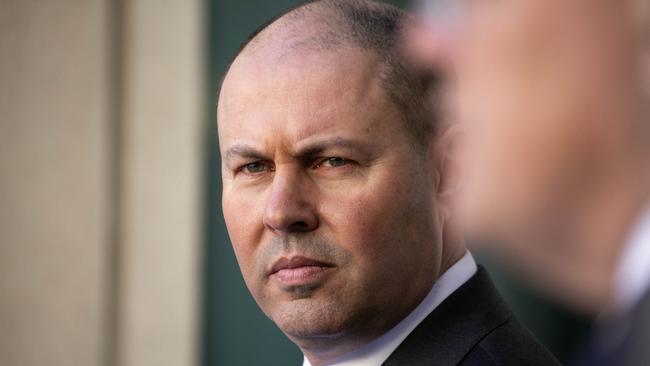
The magnitude of the nation’s social and economic crisis is revealed in the forecast of unemployment at 8.75 per cent a year from now — pointing to October budget decisions that must advance personal income tax cuts, include business tax incentives and offer more financial support.
There is one certainty: these numbers reveal a generation-long challenge. But any errors will be on the optimistic side. The risk is that the real unemployment numbers will be higher for longer, and genuine recovery a far longer travail. The forecast of official unemployment peaking at 9.25 per cent before Christmas this year assumes the Victorian lockdown works, that COVID-19 is contained across the nation and that recovery is ignited. The unemployment burden is falling heavily on women, youth, casuals and part-timers.
Australia will be a deficit nation for decades. The 2020-21 budget deficit is forecast at $184.5bn, or a staggering 9.7 per cent of GDP, compared with a “balanced” budget in 2018-19 with the deficit at $0.7bn. But the actual deficit will be higher once the budget measures and future decisions are taken on even more extensions of JobKeeper and JobSeeker.
Gross debt is forecast to reach $852bn, or 45 per cent of GDP, by June 2021 with net debt at $677bn or 36 per cent — but the good news is that Australia, starting from a far better position, will still have a low debt-to-GDP ratio compared with other nations.
Australia is haunted by two shadows — the immediate fear the virus will spiral out of control, making these numbers worse, and the 1990s legacy when it took nearly 15 years after that recession to return unemployment to 5 per cent. The road back will be long and arduous.
Treasurer Josh Frydenberg said the outlook revealed “the mountain ahead” confronting the nation.
Indeed, these numbers will risk a backlash against the government on the basis it has spent too much. Finance Minister Mathias Cormann addressed this, arguing — correctly — that the spending that blew out the deficit was justified. “What was the alternative?” he asked. It will become the Morrison government mantra.
These forecasts put the government under immense pressure in coming months to produce a jobs generation reform plan. This will become an imperative. But its diabolical dilemma will be how fast to transition away from the hefty financial support for businesses and individuals to serious reform measures to underpin sustained growth. Frydenberg left nobody in doubt; keeping the current industrial relations flexibility is essential to restoring jobs. The ACTU is on notice.
The update warned the “measured unemployment rate is a key uncertainty”. The sheer difficulty of forecasting was reflected in this comment: “Sensitivity analysis suggests that the measured unemployment rate could be between 7 per cent and 10.75 per cent by the December quarter” depending upon how hours are split between existing and new workers and what happens to the participation rate.
The update offered a variation on the nightmare problem: it took seven years in the 1990s to drive unemployment from its 11.2 per cent peak to below 7 per cent. It says the effective unemployment rate now is about 11 per cent. In short, the task of this period of Coalition government has become management of profound adversity in the dual medical and economic crises.
This situation imposes an obligation on the government to implement an aggressive plan for jobs in the October budget and that will involve even higher deficits. The numbers in the update testify to the beneficial impact of the emergency measures.
The government’s fiscal support is $162bn across 2019-20 and 2020-21, equivalent to 8.2 per cent of GDP — thereby boosting the economy by 4.25 per cent of GDP in the current year, saving an estimated 700,000 jobs and preventing unemployment from being five percentage points worse.
The update predicts real GDP to fall by 3.75 per cent in 2020 before rising by 2.5 per cent in 2021 with a strong uptake towards the latter part of that year. The virus has shot the revenue side of the budget, with tax receipts down by $32bn in 2019-20 and a huge $64bn in 2020-21 and all classes of revenue being hit.
On the spending side, the increase in support measures was worth $187.5bn over two years. The three biggest measures were JobKeeper, boosting cashflows for employers and income support (including JobSeeker).
The update warns about the unprecedented difficulty of forecasts in this situation. The assumptions that underpin these grim numbers are that global growth will be 5 per cent in 2021, that Victoria’s lockdown will be lifted after six weeks, that outbreaks in NSW are contained, that Victoria’s border closures remain only to August 19, that international travel will resume but remain at low levels until June 2021 and that net overseas migration will be a rock-bottom 31,000 in 2020-21.
It assumes, in particular, that from January 1 to June 30, 2021, while the international travel ban is lifted a two-week quarantine period will be needed for arrivals in Australia. The update warns that “the possibility of a major second wave of infections remains”. It highlights the economic cost of the nationwide March-May restrictions, saying GDP was $4bn lower each week during this period. It estimates the reintroduction of restrictions in Melbourne and Mitchell Shire will reduce national real GDP by 0.75 per cent in the September quarter.
Frydenberg argued the government stood for lower taxes — another pointer to the bringing forward of the next stage of the legislated tax cuts when the October budget is brought down. He has no interest in campaigning for GST reform. It can be assumed JobKeeper and JobSeeker will be extended again beyond their extensions to March 2021 and December 2020 respectively, as outlined this week.








Australia now enters a new and dismal age of high unemployment, record deficits and struggling enterprises. The Economic and Fiscal Update is grim on deficits yet extremely optimistic on recovery. Gross debt seems certain to exceed $1 trillion in the next couple of years.